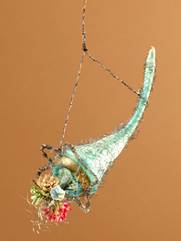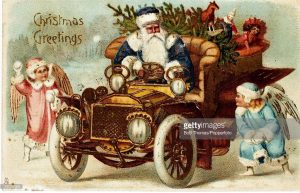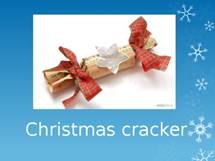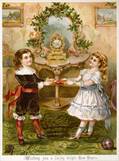
Victorian Christmas
Christmas is more than
a day in December
It's all of those things that we love to remember
Its carolers singing familiar refrains
Bright colored stockings and shiny toy trains
Streamers of tinsel and glass satin balls
Laughter that rings through the house and its halls
Christmas is more than a day in December
Its the magic and the love
That we'll always remember!
How wonderful! Christmas is near! Can you feel it?
Yes, of course. But can you imagine that people used to celebrate Christmas (if ever did) differently?
Just think a Christmas with no Christmas tree, no crackers, no Christmas cards and nobody in Britain had heard of Santa Claus! Christmas cards were not sent and most people did not have holidays from work.
It's really hard to imagine, but at the beginning of the 19th century Christmas was hardly celebrated by the British. However, by the end of the century it had become the biggest annual celebration and took on the form that we recognize today. Many of our modern-day Christmas customs have their roots in Victorian Christmas traditions.
For example, Prince Albert (Queen Victoria’s husband) was responsible for shaping how Christmas was celebrated by British Victorian families. As you already know,he was born in Germany. In Germany evergreen trees were traditionally brought into the home at Christmas time and decorated (with candles, sweets and fruit). In 1848 the royal family were pictured in the well-known magazine “The Illustrated London News” celebrating Christmas around such a decorated tree, and the fashion for Christmas trees spread very quickly from this point on.

Soon it became a must for the English to set up a Christmas tree of their own in their living room and by 1880 it had become necessary to ensure that enough trees were available around London in good time before the holiday in order to supply every family with its desired Christmas tree.
The trees were decorated with little toys, biscuits, sweets and small bags containing sweet surprises.
In
Victorian times, young ladies spent many hours making Christmas decorations.
They made little horns of plenty from coloured paper which could be filled with
dates or other sweets; from small pieces of silk and feathers, they created
little bags for candied fruits and almonds; they used cotton wool to make
little snowmen or cute angels. 

Christmas cards.
One more Victorian Christmas Tradition is the tradition of writing and sending Christmas cards.
The first Christmas card was designed by Sir Henry Cole, who was a civil servant. He created it with the help of his artist friend, John Horsley and sold it for 1 shilling. The card had three panels – the outer two panels showed some people caring the poor and the inside panel displayed a family having large Christmas dinner. In the late years of Victorian era, an English bird Robin and snow scenes became popular.
They
are very rare now and cost thousands of pounds or dollars.
By the way, Victorian children were encouraged to make their own cards and there is even evidence that Queen Victoria had her own children do this.
Traditional Victorian crackers
Do you know what is it?


No, I’ve never seen it before.
Well, it’s a Victorian Cracker!
In 1846, Tom Smith, invented a new way to sell sweets. Inspired by a trip to Paris where he saw bon bons – sugared almonds wrapped in twists of paper – he came up with the idea of the Christmas cracker: a simple package filled with sweets that snapped when pulled apart. The sweets were replaced by small gifts and paper hats in the late Victorian period, and remain in this form as an essential part of a modern Christmas.
Giving of gifts
The process of giving and receiving gifts at Christmas also became popular from Victorian era. At the beginning of the Victorian period families often gave and received presents to celebrate the New Year. But, as the importance of Christmas as a family celebration grew, the gift-giving was moved to Christmas.
The first Victorian Christmas presents were fairly small – gifts such as fruits, nuts, sweets and handmade items were hung from the branches of the Christmas tree.
The size and expense of the gifts steadily increased. Victorians started to buy gifts from shops and they were often too big to hang from the tree. By the end of the Victorian era, many families had taken to leaving Christmas gifts under the tree.
Santa Claus
Santa Claus also comes from Victorian England. Wherever you go, Father Christmas and Santa Claus are regarded as the bringers of gifts. Their histories are completely different however. Father Christmas arose from an English winter custom. Originally, he was dressed in green and was a symbol of the approaching spring. St. Nicolas (Sinter Klaas) found his way from Holland to America, arriving in the 17th century. From 1870, Sinter Klaas became known as Santa Claus in England and took over the role of bearer of gifts.
And last but not least, Christmas feast
The roast turkey also has its beginnings in Victorian Britain. Previously other forms of roasted meat such as beef and goose were the centerpiece of the Christmas dinner. The turkey was added to this by the more wealthy sections of the community in the 19th century, but its perfect size for a middle class family gathering meant it became the dominant dish by the beginning of the 20th century.
The family was really important to the Victorians. They saw Christmas as a time to focus on family relationships, and most of the Victorian Christmas traditions (such as gift giving, eating a Christmas dinner, decorating the Christmas tree) were shared by all of the family members.
Скачано с www.znanio.ru
Материалы на данной страницы взяты из открытых источников либо размещены пользователем в соответствии с договором-офертой сайта. Вы можете сообщить о нарушении.